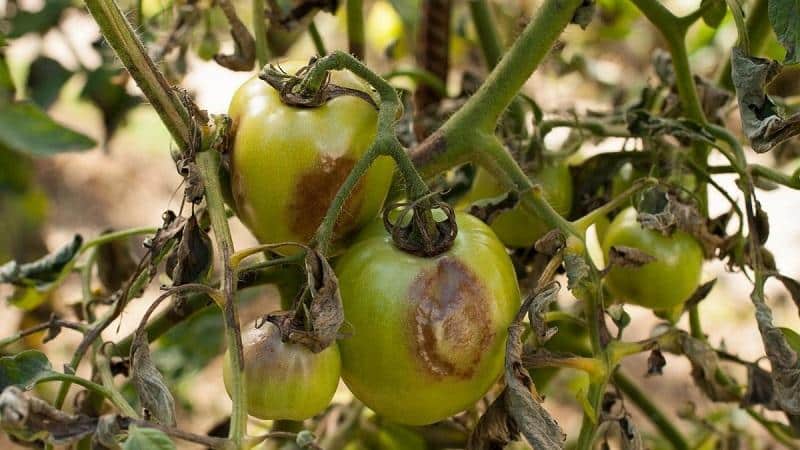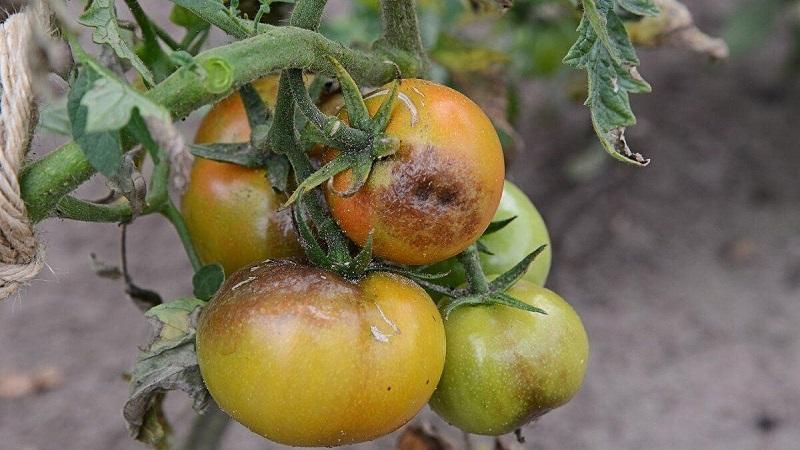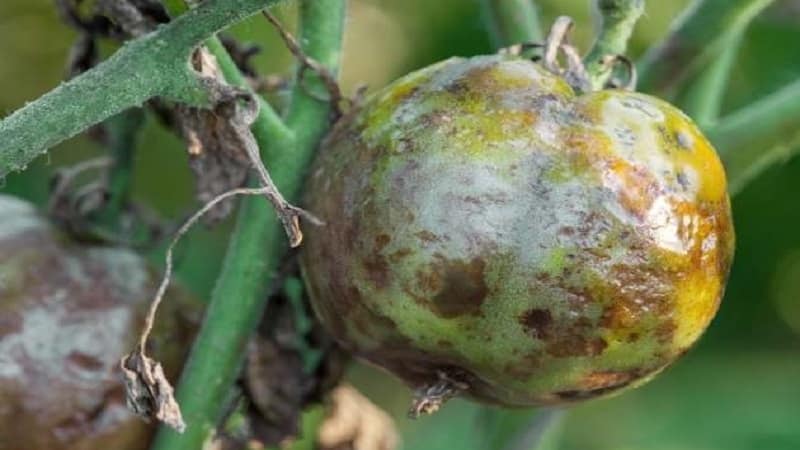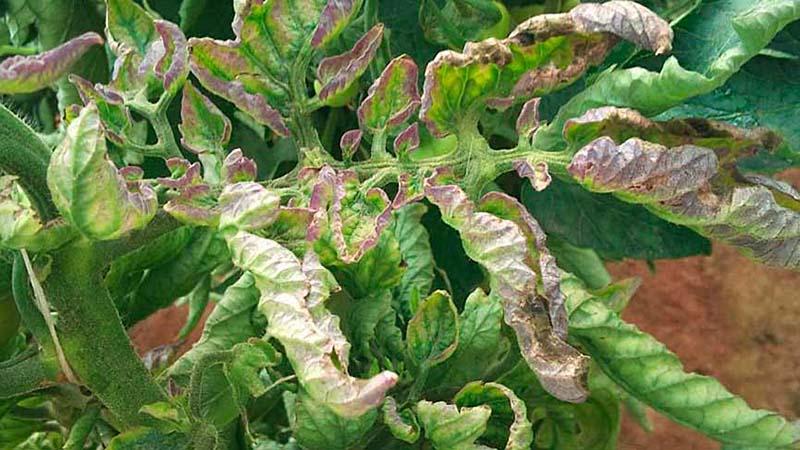Preserving an affected tomato crop or how to save tomatoes from late blight if they are already sick
Late blight is a problem familiar to most gardeners. This fungal disease annually threatens the harvest of many plants: potatoes, peppers, eggplants and other plantings. This includes tomatoes. Appearing on one bush, late blight soon covers all plants.
In a couple of days, the entire crop can die if measures are not taken in time. In this article you will learn how to identify late blight infection in tomatoes, how to save tomatoes from late blight if they are already sick, and what are the preventive measures.
Signs of late blight infection in tomatoes
Phytophthora is a fungus that develops in conditions of high humidity. It infects the plant directly from the soil or is carried by the wind from diseased bushes to healthy ones.
Most often, the first signs of the disease appear on the leaves. They are covered with dark gray and brown spots, sometimes with a white fluffy coating on the back side. The stem is also covered with spots. The inflorescences turn yellow, darken and soon fall off.
 Fruits are also affected. Brown or black spots of uneven shape appear on them. Over time, they merge into one spot. The tomato changes shape, becomes ugly, softens and eventually rots, emitting an unpleasant odor.
Fruits are also affected. Brown or black spots of uneven shape appear on them. Over time, they merge into one spot. The tomato changes shape, becomes ugly, softens and eventually rots, emitting an unpleasant odor.
Late blight can appear on fruits even after harvesting. Infected vegetables begin to darken and rot during storage and ripening.
How to deal with late blight if tomatoes are already sick
Often, when the disease progresses, infected plants cannot be saved - they are urgently disposed of to avoid an epidemic. If the disease is detected in the early stages, then tomatoes can be cured, for which there is a number of methods.
Chemicals
The stronger the plant, the less susceptible it is to disease. Increase the immunity of tomatoes by feeding them with phosphorus-potassium fertilizers.
If infected, immediately remove the affected leaves and fruits, and then spray the bushes with a fungicide. After a week process only fruits with a solution of calcium chloride. A 10% solution is sold in pharmacies. It is diluted with water in a ratio of 1:3.
Note! Do not use chemicals when infecting ripe fruits. Chemical treatment is only appropriate when the fruits are still green.

Traditional methods
If you don't like chemicals and are concerned about the environmental friendliness and quality of the crop, try traditional methods. They are also effective in combating late blight:
- One of the available means is iodine. This is an excellent disinfectant. Prepare a solution of 1 liter of milk, 1 bucket of water and 15-25 drops of iodine, spray the infected plants.
- A simpler solution: mix milk and water in a 1:1 ratio and spray the tomatoes daily.
- Garlic mixture. Chop 100 g of garlic and pour in 200 g of boiled water. Let it brew for a day and add 1 g of potassium permanganate. Dissolve in 10 liters of water and use the solution for spraying.
- Many gardeners recommend a saline solution. It will create a film on the tomatoes that will protect the fruit. To do this, dissolve a glass of salt in 10 liters of water.
Agrotechnical techniques
If you do not want to remove the bush, try piercing the diseased plant with copper wire.This will enrich the tomato with oxygen and normalize chlorophyll levels, making it more resistant to disease.
Calcine the wire in a fire, cut a small piece about 5 cm long and insert it into the stem at a height of 10-12 cm above the soil level, bending the ends down.
Important! If it was not possible to save the plant from late blight, it is important to remove it correctly. Under no circumstances should you throw the bush into a compost pit, as when you subsequently fertilize the garden with humus, this will provoke new infections. Burn the diseased bush away from healthy ones.
How to save the harvest
Treatment of an infected crop in a greenhouse and in open ground has few differences. The main nuances are in preventive measures.
In the greenhouse
In the greenhouse, thanks to protection from excess moisture - rain, dew, fog - favorable conditions are created for the development of the late blight fungus. But this only works if the greenhouse is regularly ventilated.
It is better to treat infected plants with folk remedies, since chemical treatment in a closed and stuffy greenhouse poisons the air. After plants are cured or removed, pay special attention to the soil. After harvesting, it is treated with a solution of “Fitosporin” so that the fungus dies and does not infect the plantings next year.

In the open ground
Outdoors, tomatoes are more susceptible to disease, as rain and dew create favorable conditions for fungal growth. When infected, use chemicals, treating plants in clear weather in the morning or evening. On average, this is done once every 10-14 days. But keep in mind that many drugs are easily washed off by rain.
What to do if late blight has affected the fruits
Even if the disease has reached the fruits, do not despair.The harvest can still be saved and even eaten.
How to save
Collect fruits affected by late blight into a common container. Pour warm, almost hot water or potassium permanganate solution over the tomatoes for a couple of minutes. This will kill bacteria. Then thoroughly dry each vegetable and wrap it in paper to prevent the fruits from contaminating each other. Leave the tomatoes to ripen in a clean and dry place.
Is it possible to eat them
If late blight has not penetrated deep into the fruit, then the tomatoes can be eaten by cutting off the layer damaged by rot.
How to save green tomatoes
If a plant with unripe fruits is sick, then green tomatoes can be saved. Collect fruits without signs of disease - they should be whole, dense, without black or brown spots. Next, be sure to rinse with warm water - this will wash away the bacteria from the fruit.
Then leave to dry in a warm place out of direct sunlight. The active sun will wrinkle the tomatoes, not allowing them to ripen. After a couple of weeks, you can harvest the first ripe tomatoes.

Preventive measures
It is known that it is better to prevent a disease than to treat it, therefore:
- Before planting, be sure to disinfect the soil. This will reduce the possibility of late blight to a minimum.
- Plant tomatoes after beets, cucumbers, onions, cabbage, and carrots.
- Water your tomatoes early in the morning.
- If tomatoes are growing in a greenhouse, be sure to ventilate the room to avoid condensation.
- Do not forget to loosen the soil for better aeration of the roots.
- Do not neglect feeding plants with biologically active and folk remedies.
Tips and tricks
When irrigating, make sure that water does not get on the plant and fruits - it is convenient to use drip irrigation systems for this.
Fighting late blight It will be more effective if you feed the plants with phosphorus or potassium. And, of course, do not despair if the plants are sick - they can be saved if you put in enough effort.
Conclusion
Late blight annually affects tomatoes in regions with different climates. But infected fruits can be saved and even eaten, so don’t rush to get rid of them. Chemical and natural remedies and agricultural techniques will help in the fight.
Carefully monitor your garden: it is easier to overcome tomato late blight if you notice it in the early stages. And, of course, the most effective remedy is prevention. With proper planting and care, you will not have to fight the disease.